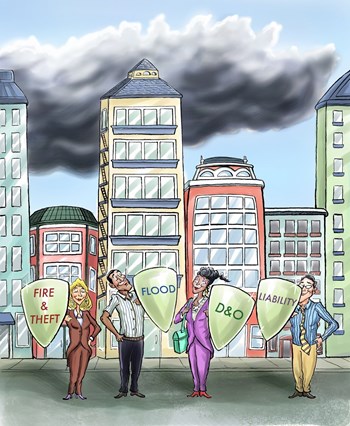
Good afternoon—and welcome to the board. Your mission should you choose to accept it is to make decisions to better your building. The residents may not like you and, more importantly, may not like those decisions. Nevertheless, keep doing the job you’re doing. In a worst-case scenario, you will be sued. Perhaps more than once. Should anything go wrong, don’t worry; you’re protected by the board's D&O insurance. Good luck.”
On-the-Job Protection
You volunteer to be on your co-op or condo association’s board. You do your best to help make the right decisions and make your building a great place to live. Unfortunately, one of your fellow residents doesn’t like a decision you made and takes you and the rest of the board to court. They are suing for thousands of dollars—maybe even millions. Your home, life savings and other assets are at risk if you lose.
With stakes like that, it would be virtually impossible for co-op and condo boards to find volunteers if there wasn't some form of protection from lawsuits resulting from the decisions made by board members in the course of doing their job. Fortunately, that protection exists, in the form of Directors and Officers, or D&O insurance.
Some people think that it's only the board that starts the lawsuits when homeowners are late with dues, or because they broke the rules, but lawsuits are a two-way street, says Kevin M. LaCroix, Esq., executive vice president of OakBridge Insurance Services, an Ohio-based insurer with clients in New York City.
“They can be sued by members of the HOA and by third parties who provide services or goods to the association,” says LaCroix. “There’s no reason to serve on a board and face risk of potential liability without adequate coverage.”
Take a recent lawsuit profiled in The New York Times where the former president of a co-op board sued the board, claiming that racial discrimination was the reason the board did not let him buy a neighboring apartment. The board debated that the resident couldn’t afford both units. They went to court—and the legal fee meter started ticking overtime.
A few years ago, Moneymagazine profiled an ongoing legal battle in California where a homeowners association was suing a resident for taking too long to do their landscaping. The resident lobbied back with a countersuit.
In Michigan, a resident filed a lawsuit to against his condominium association to resolve a dispute over who should pay for a road repair in a condominium complex where he owns a unit. The resident wasn’t happy that the association was assessing the residents to pay almost $30,000 to repair an access road, which the resident said was a public road. The resident decided to sue the board and let a judge decide.
“People get emotionally excited about what you do as a board member,” says Kevin Davis, president of Kevin Davis Insurance in Los Angeles, California. “You tell them no you can’t have a pet, or hang your laundry on the balcony. The residents will say ‘Who are you to tell me that I can’t?’ It’s the number-one reason for lawsuits.”
Crash-Helmet Coverage
Think of D&O, or directors and officers, insurance, as your own personal protective helmet from fastball lawsuits. “The main intent is to protect the directors and officers and the association for their decision-making in the event that they are sued,” says Adam S. Collins, CIC, and assistant vice president at Aon Affinity, Ian H. Graham Insurance in Sherman Oaks, California, which has multiple clients in New York City.
“Volunteers are making decisions that often times involve large amounts of money that can impact every unit owner within the association,” says Collins. “Without D&O coverage, board members' personal assets are at stake. Often, the building's [conditions, covenants and restrictions] CC&Rs and bylaws will have some form of an indemnification clause but this would ultimately result in assessments against the board and fellow unit owners as your defense fund. In the event that association only is named, then the association will essentially be self-insured and will be responsible for all legal fees incurred as a result of the claim. D&O coverage is there to allow these volunteers—who are simply trying to do the right thing—sleep at night for their decision making.”
Fortunately, Davis says that most lawsuits really don’t have anything to do with money. “They are suing because they want a right to do something,” he says. “For example, an individual in Unit H on the second floor had a nice view but now a tree is blocking it. He asks to have it cut down. The resident in the unit below him says no, it’s shading his apartment. In this case, the board didn’t uphold their fiduciary responsibility. If Unit H bought a view, they need to make sure they maintain the view, so they’ll go to court, just to see who’s right and who’s wrong.”
Whos & Whats
To find out if your board has a policy, just ask. However, don’t assume you’re automatically covered without taking a good look at the policy. Like fingerprints, every D&O policy is different.
Collins also recommends that co-ops and condos purchase a stand-alone D&O policy as opposed to an endorsement that can be added to the larger package policy. “If you have an embedded form that incorporates the D&O on a package policy, with other coverages, such as property, general liability, and so forth, it typically only covers the current directors and officers,” he says. “A stand-alone policy will typically protect all past, present and future board members, committee members, and the property manager. It depends on the quality of the coverage that is purchased.”
Also, remember “a stand alone policy automatically includes the property manager as an insured, whereas most embedded forms do not,” he adds. “In addition, other key coverages that are included, such as non-monetary relief, third-party discrimination, failure to maintain or obtain insurance, and employment practices liability, are usually excluded under the D&O coverage provided by the package policy.”
There are other exclusions as well. “The myth is that D&O insurance covers everything, which obviously isn’t true,” says Collins. “Some of the more important exclusions contained in a D&O policy are damage or destruction to tangible property, bodily injury, construction defects, and intentional criminal acts.”
That last item is a very important one. Does D&O coverage protect the co-op, condo, or HOA from criminal actions by the director or officers? It seems a straightforward enough question, but it can sometimes be surprisingly tough to answer.
“Most, if not all, D&O policies contain a provision that excludes intentional criminal and fraudulent acts committed by board members,” says Collins. “However, [our policy] will continue to defend the directors and/or officers until such time that a criminal action can be proven. The policy will then cease to provide any further protection once it is determined that a board member knowingly committed a criminal or fraudulent act.”
D&O coverage also doesn't indemnify a board or board member against decisions made “in bad faith,” or with illegal intent. If a board is found to have acted in an illegal manner—deliberately discriminating against a prospective buyer, for example—and are hit with punitive damages, members are on their own when it comes to paying them.
What is the Cost?
A stand-alone policy typically starts at a minimum annual premium of around $1,200 and will increase depending on the number of units in the building and other factors. The co-op or condo is generally responsible for paying the premium for this specific type of coverage.
“Premiums can also be impacted by additional exposures—such as commercial tenants, to name one—and/or the number of employees,” says Collins.
When it comes time to cutting a check, Collins says that not all D&O policies are created equal. “Most stand-alone policies contain a ‘Duty to Defend’ provision,” says Collins. “In other words, our D&O provides a defense for the board once they accept the claim. The obvious benefit is that the association doesn’t have to front the money (except for the retention) in hopes of having it reimbursed to them by the association or the insurance policy, as is the case with a standard D&O policy or embedded form. The converse to that is an ‘indemnification’ provision is contained in some less comprehensive D&O forms.”
If your association doesn’t have or won’t get insurance, the Nonprofit Risk Management Center (NRMC), says that every state has a volunteer protection law and the federal Volunteer Protection Act (VPA) became effective in September. The VPA provides that, if a volunteer meets certain criteria, he or she shall not be liable for simple negligence while acting on behalf of a nonprofit or governmental organization.
The VPA also provides limitations on the assessment of non-economic losses and punitive damages against a volunteer. The Volunteer Protection Act does not, however, protect a volunteer from liability for harm “caused by willful or criminal misconduct, gross negligence, reckless misconduct, or a conscious, flagrant indifference to the rights or safety of the individual harmed by the volunteer.” The act does not prohibit lawsuits against volunteers nor does it provide any protection for nonprofits.
Some of the notable stand-alone D&O programs that are specifically tailored to community associations are written with CNA, Travelers, Great American, Chubb and Chartis.
To reduce any potential expenses from D&O insurance, it’s best to have a board that is well informed of their responsibilities. “Know, understand and follow the bylaws and CC&R’s, educate all board members, and attend law seminars, risk management seminars, specifically designed for community association boards,” advises Collins, who also recommends both The Cooperator and the Community Associations Institute (CAI) as two viable resources for board member education.
It's tough enough to get people interested in taking positions on their co-op or condo board without the threat of lawsuit damages hanging over their heads. Board education and good communication are two pieces of protection against legal action; a solid D&O policy is a vital third piece of the puzzle. n
Lisa Iannucci is a freelance writer and author and a frequent contributor to The Cooperator and other publications.






2 Comments
Leave a Comment